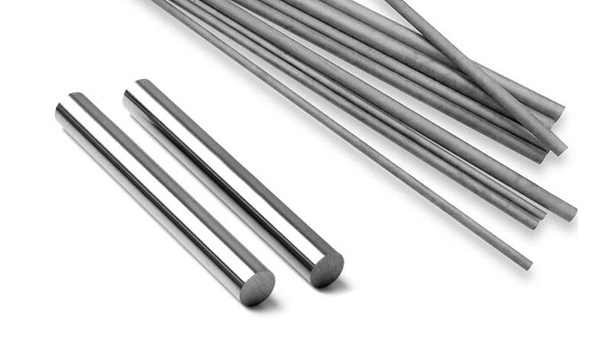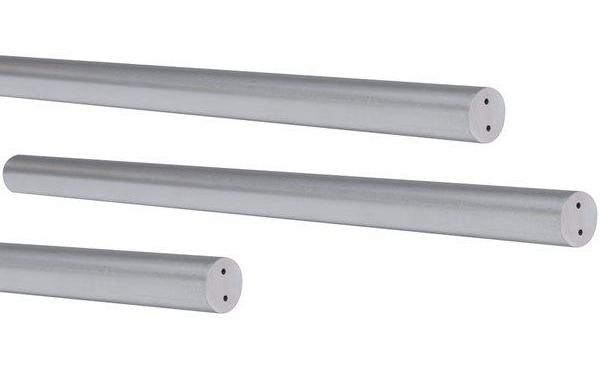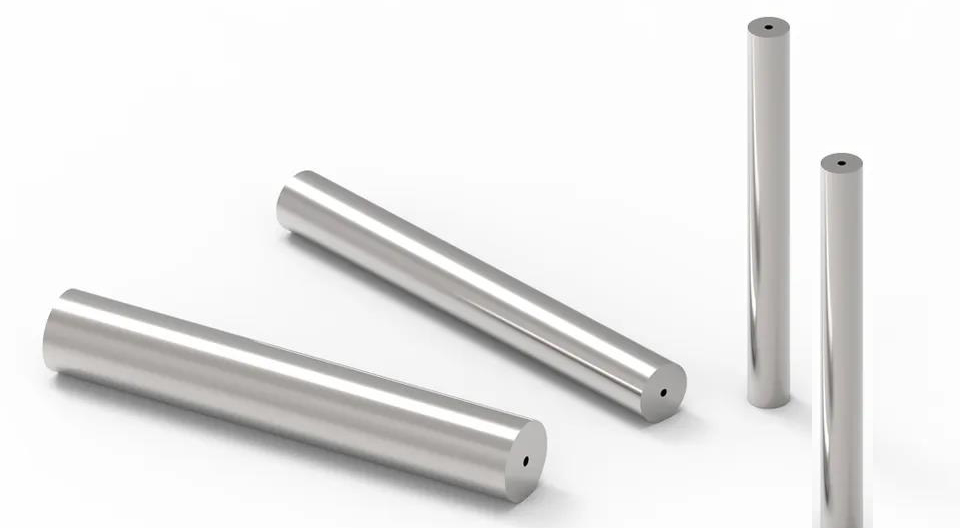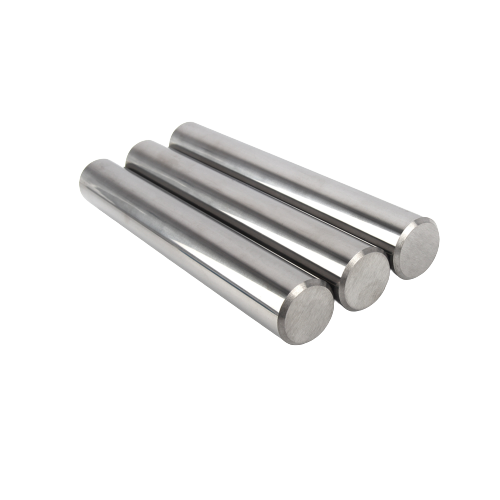В мире высокоточной обработки, где допуски измеряются микронами, а производительность имеет первостепенное значение, твердый твёрдый сплав стержни царят в мире. Эти чудеса инженерной мысли, созданные из невероятно твердого и износостойкого карбида вольфрама, составляют основу бесчисленных режущих инструментов и быстроизнашивающихся деталей, которые используются в самых разных отраслях промышленности - от аэрокосмической до медицинской.
Но не все твердосплавные стержни созданы одинаковыми. В этом подробном руководстве рассматриваются все тонкости четырех основных твёрдый твёрдый сплав Типы станков, каждый из которых обладает уникальными характеристиками и преимуществами, предназначенными для решения конкретных задач обработки:
- Прямой твердосплавный стержень с отверстием для охлаждающей жидкости
- 2 прямых отверстия для охлаждающей жидкости Твердосплавный стержень
- 2 спиральных отверстия для охлаждающей жидкости Твердосплавный стержень
- Стержень из твердого сплава с фаской на конце
Это руководство поможет вам сориентироваться в мире твердосплавных стержней и выбрать идеальный тип для прецизионной обработки - от понимания их отличительных характеристик до изучения различных областей применения.
Обзор: Сила точности в ваших руках
Твердые твердосплавные стержни, в отличие от стальных аналогов, сохраняют свою твердость и прочность даже при экстремальных температурах, что делает их идеальными для высокоскоростных операций обработки, при которых возникает проблема выделения тепла. Их исключительная износостойкость позволяет увеличить срок службы инструмента, сократить время простоя и, в конечном счете, снизить производственные затраты.
Добавление отверстий для охлаждающей жидкости и других элементов еще больше повышает их производительность, обеспечивая эффективный отвод стружки, улучшенный теплоотвод и повышенную скорость резания, расширяя границы возможного в прецизионной обработке.
Подробное введение: Знакомство с миром твердых твердосплавных стержней
Что такое твердый твердосплавный стержень?
Твердый твердосплавный стержень, как следует из названия, представляет собой цилиндрический стержень, полностью изготовленный из карбида вольфрама, цементированного твердого сплава, известного своей исключительной твердостью и износостойкостью. Эти стержни служат исходным материалом для изготовления широкого спектра режущих инструментов и быстроизнашивающихся деталей, используемых в различных отраслях промышленности.
Принцип работы твердосплавных стержней при обработке
Твердосплавные стержни при обработке в режущие инструменты работают по принципу деформация сдвига. Невероятно твердые режущие кромки твердосплавных инструментов, сформированные из пруткового материала, способны разрезать заготовки за счет превышения прочности материала на сдвиг. Геометрия режущего инструмента, а также его параметры резания определяют эффективность и качество реза.
Как используются твердосплавные стержни?
Твердые твердосплавные стержни обычно обрабатываются в различных режущих инструментах, включая:
- Концевые фрезы: Для операций формования и профилирования.
- Учения: Для создания отверстий в различных материалах.
- Расширители: Для расширения и отделки существующих отверстий.
- Пользовательские инструменты: Подбирается под конкретные требования к обработке.
Как обрабатываются стержни из твердого сплава?
Обработка твердосплавных стержней требует специального оборудования и технологий из-за их чрезвычайной твердости. Для придания формы и чистовой обработки твердосплавных стержней обычно используются алмазные шлифовальные круги. Прецизионные шлифовальные станки, часто с ЧПУ, используются для достижения жестких допусков и сложной геометрии, необходимых для высокопроизводительных режущих инструментов.
Классификация и типы твердых твердосплавных стержней
Твердые твердосплавные стержни классифицируются по различным признакам, включая:
- Твердый сплав: Определяет твердость, вязкость и износостойкость прутка.
- Диаметр и длина: Доступен широкий ассортимент стандартных и нестандартных размеров.
- Конфигурация отверстия для охлаждающей жидкости: Прямые, спиральные или без отверстий для охлаждающей жидкости.
- Отделка поверхности: Шлифованные, полированные или с покрытием.
Тенденции рынка твердосплавных стержней
Мировой спрос на твердые твердосплавные стержни растет, что обусловлено все более широким внедрением передовых производственных технологий, особенно в таких отраслях, как аэрокосмическая, автомобильная и медицинская. Рынок характеризуется острой конкуренцией: производители постоянно внедряют инновации, разрабатывая новые марки твердого сплава и конструкции инструментов, которые обеспечивают повышенную производительность и экономическую эффективность.
Раскрытие 4 основных типов твердосплавных стержней: Сравнительный анализ
| Характеристика | Твердый твердосплавный стержень | 1 Прямое отверстие для охлаждающей жидкости | 2 прямых отверстия для охлаждающей жидкости | 2 спиральных отверстия для охлаждающей жидкости | 1 Конец с фаской |
|---|---|---|---|---|---|
| Изображение | |||||
| Описание | Сплошной цилиндрический стержень из карбида вольфрама. | Стержень из твердого сплава с одним прямым отверстием для охлаждающей жидкости, проходящим через его центр. | Стержень из твердого сплава с двумя параллельными прямыми отверстиями для охлаждающей жидкости. | Твердосплавный стержень с двумя спиральными отверстиями для отвода стружки. | Цельный твердосплавный стержень с фаской на одном конце и точной шлифовкой для точной установки длины инструмента. |
| Расход охлаждающей жидкости | Нет | Охлаждающая жидкость для сквозных инструментов | Охлаждающая жидкость для сквозных инструментов | Охлаждающая жидкость для сквозных инструментов | Нет |
| Эвакуация микросхем | Ограниченный | Улучшенный | Дальнейшее совершенствование | Superior | Ограниченный |
| Приложения | Обработка общего назначения, быстроизнашивающиеся детали | Сверление, развертывание, фрезерование | Глубокое сверление, крупносерийная обработка | Высокопроизводительная обработка, труднообрабатываемые материалы | Заготовки для долот, изготовление инструментов на заказ |
| Преимущества | Экономичный, универсальный | Улучшенное удаление стружки, улучшенное охлаждение | Сбалансированный поток охлаждающей жидкости, повышенная жесткость | Оптимальное удаление стружки, высокая скорость резания | Точная длина инструмента, сокращение времени настройки |
| Ограничения | Эвакуация чипов может быть сложной задачей | Одно отверстие для охлаждающей жидкости может ограничить поток охлаждающей жидкости | Спиральные отверстия могут ослабить структуру стержня | Дороже, чем прямые отверстия для охлаждающей жидкости | Не подходит для применения охлаждающей жидкости через инструмент |
Таблица 1: Сравнительный анализ 4 основных типов твердосплавных стержней




Приложения: Где главенствует точность
Универсальность твердых твердосплавных стержней отражается в их разнообразном применении во многих отраслях промышленности:
- Аэрокосмическая промышленность: Производство компонентов двигателей, лопаток турбин и конструкционных деталей.
- Автомобиль: Производство компонентов двигателей, трансмиссионных механизмов и подшипников.
- Медицина: Создание хирургических инструментов, имплантатов и стоматологических инструментов.
- Изготовление пресс-форм: Изготовление пресс-форм для литья пластмасс под давлением, литья под давлением и других процессов.
- Энергия: Сверление и обработка компонентов для нефтегазовой разведки и производства электроэнергии.
- Электроника: Микрообработка электронных компонентов и печатных плат.
Преимущества и ограничения: Взвешивание плюсов и минусов
| Характеристика | Преимущества | Ограничения |
|---|---|---|
| Твердость и износостойкость | Исключительная твердость и износостойкость, что увеличивает срок службы инструмента и повышает производительность резания. | Могут быть хрупкими и склонными к сколам при ударах или высокой вибрации. |
| Высокотемпературная стабильность | Сохраняет твердость и прочность при повышенных температурах, позволяя выполнять высокоскоростную обработку. | Обработка твердого сплава требует специального оборудования и опыта из-за его чрезвычайной твердости. |
| Коррозионная стойкость | Высокая устойчивость к коррозии и химическому воздействию, подходит для использования в суровых условиях. | Может быть дороже, чем другие инструментальные материалы, например, быстрорежущая сталь. |
Таблица 2: Преимущества и ограничения твердых твердосплавных стержней
Похожие статьи: Расширение горизонтов карбида
- Важность выбора марки твердого сплава: Выбор правильной марки твердого сплава имеет решающее значение для оптимизации производительности и долговечности инструмента. Необходимо учитывать такие факторы, как обрабатываемый материал, скорость резания, скорость подачи и требуемая чистота поверхности.
- Роль покрытий в производительности твердосплавных инструментов: Покрытия, такие как TiN, TiAlN и алмазоподобный углерод (DLC), могут дополнительно повысить износостойкость, смазывающую способность и устойчивость к окислению твердосплавных инструментов.
- Достижения в производстве твердосплавных стержней: Инновации в порошковой металлургии и процессах спекания приводят к созданию новых марок твердых сплавов с улучшенными свойствами, такими как более мелкая зернистая структура и повышенная прочность.
Вопросы и ответы: Ответы на ваши вопросы о твердосплавных стержнях
1. В чем основное различие между твердыми твердосплавными стержнями и твердосплавными вставками?
Твердосплавные стержни используются для изготовления цельных режущих инструментов, а твердосплавные пластины - это сменные режущие кромки, которые крепятся к держателям инструментов. Инструменты из твердого сплава обладают большей жесткостью и обычно используются для высокоточных работ, а твердосплавные пластины обеспечивают универсальность и экономическую эффективность.
2. Как выбрать правильную конфигурацию отверстия для охлаждающей жидкости для моего применения?
Выбор конфигурации отверстия для СОЖ зависит от операции обработки, обрабатываемого материала и требуемого отвода стружки. Прямые отверстия для СОЖ подходят для обработки общего назначения, а спиральные - для высокопроизводительных операций, где отвод стружки имеет решающее значение.
3. Можно ли перешлифовать или заточить инструменты из твердого сплава?
Да, инструменты из твердого сплава можно многократно шлифовать и перетачивать, что продлевает срок их службы и сокращает расходы на оснастку. Однако, чтобы не повредить твердый сплав, необходимо использовать специализированное шлифовальное оборудование и технологии.
4. Каковы меры предосторожности при работе с твердыми твердосплавными стержнями и инструментами?
Карбид очень твердый и может разлететься на куски при ударе. При работе с твердым сплавом всегда надевайте защитные очки, перчатки и соответствующую одежду. Соблюдайте осторожность при обработке твердого сплава, так как стружка может быть очень острой и горячей.
5. Где можно приобрести высококачественные твердые твердосплавные стержни?
Авторитетные производители и поставщики твердосплавных стержней могут предоставить высококачественную продукцию, соответствующую вашим конкретным требованиям. При выборе поставщика учитывайте такие факторы, как опыт, сертификаты качества и поддержка клиентов.
Хотите купить дешевые карбид вольфрама стержни по хорошим ценам? пожалуйста, нажмите здесь.




